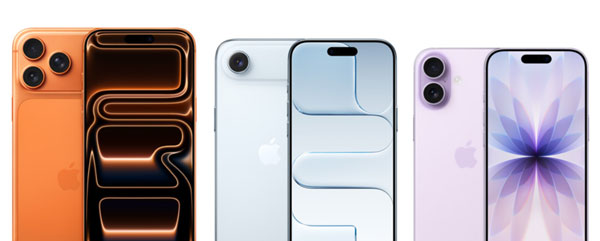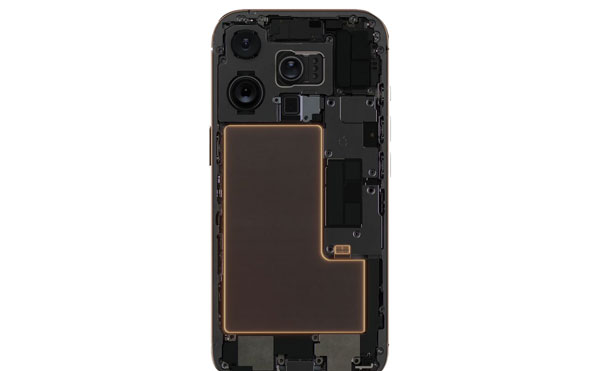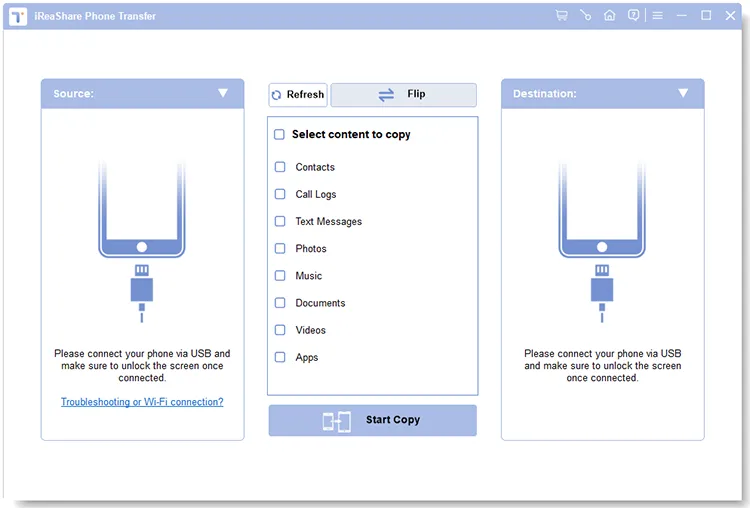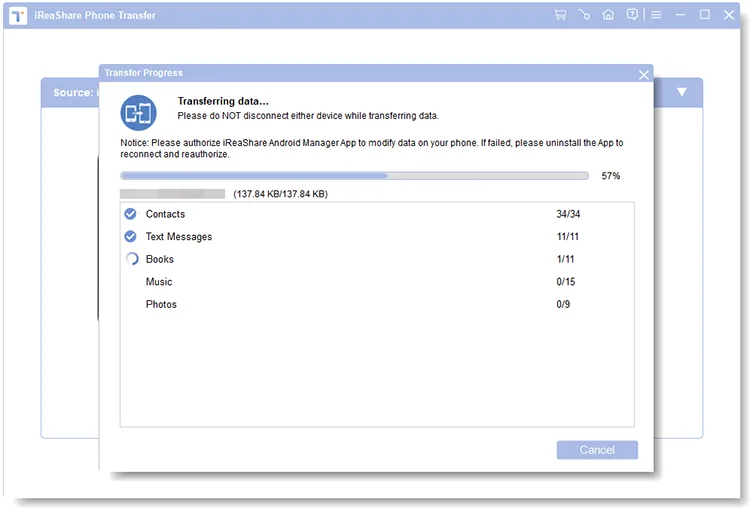Apple continues to refine its product lineup this year. Two standout models from their lineup are the iPhone 17 Series and the iPhone Air. Each phone offers its unique features tailored to different user needs and preferences. In this article, we'll compare iPhone 17 Series and iPhone Air in terms of hardware, software, and pricing.

- Part 1: Compare iPhone 17 Series and iPhone Air in Hardware
- Part 2: Compare iPhone 17 Series and iPhone Air in Software
- Part 3: Compare New iPhone 17 Series and iPhone Air in Pricing
- Part 4: FAQs About iPhone 17 Series and iPhone Air
- Part 5: Transfer Data to Your New iPhone 17 or iPhone Air in 1 Click
Take a quick look at the pros and cons of iPhone 17 series and iPhone Air:
| Model | Pros | Cons |
|---|---|---|
| iPhone 17 | 1. Offers a strong balance of features and performance for the price. 2. Features a ProMotion display with a 120Hz refresh rate, a significant upgrade from previous non-Pro models 3. Includes a dual-camera setup with a new 48MP ultrawide lens 4. Provides up to 30 hours of video playback |
1. The USB-C port is limited to slower USB 2.0 transfer speeds 2. Uses the A19 chip, which is less powerful than the A19 Pro 3. Has a thicker, more standard design compared to the iPhone Air |
| iPhone 17 Pro & Max | 1. Features the A19 Pro chip with a vapor chamber for sustained performance 2. All three rear cameras are 48MP, including an 8x optical zoom telephoto lens 3. Supports 40W wired charging and USB 3.2 speeds 4. The Pro Max model offers the longest battery life of any iPhone 5. Includes ProRAW and ProRes video, and a LiDAR scanner for advanced photography and AR |
1. The Pro models are the heaviest and thickest of the lineup 2. Comes with a premium price tag for the advanced features 3. Reverts to an aluminum frame from titanium, which may be seen as a downgrade by some |
| iPhone Air | 1. The thinnest and lightest iPhone ever made, making it incredibly portable 2. Surprisingly features the A19 Pro chip, providing high-end performance 3. Has a 6.5-inch screen, larger than the standard iPhone 17 4. Supports USB 3.0 speeds via the USB-C port |
1. Has only one rear camera, lacking the versatility of ultrawide and telephoto lenses 2. Has the smallest battery and shortest battery life of the lineup 3. Lacks a stereo speaker system 4. Costs significantly more than the standard iPhone 17 |
Part 1: Compare iPhone 17 Series and iPhone Air in Hardware
The fundamental differences between the iPhone 17 Pro Max, iPhone 17 Pro, iPhone 17, and iPhone Air become immediately apparent when examining their hardware specifications. If you want to take a close look at the hardware of iPhone 17 Pro vs Air, iPhone 17 vs iPhone 17 Pro, etc., including the processors, display, camera, battery, dimensions, weight, and more, don't miss this part.
1.1 Processor
Both phones are powered by Apple's latest silicon, but with a notable distinction in performance tiers.
The standard iPhone 17 is equipped with the A19 bionic chip, featuring a 6-core CPU and a 5-core GPU. It's built on an advanced 3nm process and includes a 16-core neural engine for handling machine learning and AI tasks efficiently.
The iPhone Air, meanwhile, steps up to the more powerful A19 Pro chip. While it shares the same 6-core CPU and 5-core GPU configuration as the A19 in the standard iPhone 17, it offers enhanced processing capabilities, placing it in a higher performance bracket alongside the Pro models.
1.2 Display and Camera
This is where the four models diverge significantly in their approach.
Display
All four models in the iPhone 17 series now feature ProMotion OLED displays with a 120Hz adaptive refresh rate, a significant upgrade for the base and Air models. This technology allows for smoother scrolling and more fluid animations.
- iPhone 17 and iPhone 17 Pro: Both have a 6.3-inch Super Retina XDR display, a size increase for the standard model.
- iPhone 17 Air: This new model features a 6.5-inch OLED display in an ultra-thin chassis, making it the slimmest iPhone.
- iPhone 17 Pro Max: The largest of the group, it has a 6.9-inch Super Retina XDR display.
Brightness and Durability: The Pro and Pro Max models can reach a peak brightness of 3000 nits, which is 2x better for outdoor contrast. All models are protected by the new Ceramic Shield 2, which is three times more scratch-resistant than the previous version.
Camera
The camera systems differentiate the models, with the Pro and Pro Max offering the most advanced features and hardware. A notable change across the entire lineup is the new 18MP Center Stage front camera that can take landscape selfies without rotating the phone.
- iPhone 17: Features a dual-camera setup with a 48MP Main lens and a 48MP Ultra Wide lens. It also offers a 2x telephoto option with optical-quality zoom by using the main sensor.
- iPhone 17 Pro and 17 Pro Max: This model steps up to a triple-camera system, with all three lenses at 48MP: Main, Ultra Wide, and a Telephoto lens with 4x optical zoom. It also includes a LiDAR scanner for enhanced depth sensing and augmented reality features.
- iPhone 17 Air: Comes with a single 48MP rear camera. Despite having only one lens, it's capable of taking 12MP optical-quality 2x telephoto images.
1.3 Battery and Charging
The iPhone 17 lineup brings a mix of battery and charging enhancements, with the Pro and Pro Max models leading the pack in both capacity and speed, while the new iPhone Air makes strategic compromises for its ultra-thin design.
Battery Capacity & Life
- iPhone 17: The battery capacity is 3,692 mAh, a slight increase from the previous generation. Apple claims this provides an all-day battery life, with up to 30 hours of video playback.
- iPhone 17 Pro: This model sees a significant jump in battery size to 4,252 mAh. The larger battery, combined with the A19 Pro chip's efficiency, enables up to 33 hours of video playback.
- iPhone 17 Pro Max: As the largest model, it has the biggest battery, which is now over 5,000 mAh for the first time on an iPhone, at 5,088 mAh. This allows for the longest battery life of any iPhone, with a claimed 39 hours of video playback.
- iPhone Air: To achieve its slim profile, the iPhone Air has the smallest battery in the lineup at 3,149 mAh. Despite the smaller size, Apple's software and chip efficiency allow it to still deliver a respectable battery life, with up to 27 hours of video playback. The battery uses a new silicon-anode chemistry to pack more energy into a smaller space.

Wired Charging
- iPhone 17, iPhone 17 Pro, and iPhone 17 Pro Max: These models support a new "Dynamic" charging protocol, which allows them to be charged up to 50% in approximately 20 minutes with a compatible 40W or higher power adapter. This is a noticeable improvement over previous models.
- iPhone Air: Due to its smaller battery and thermal constraints, the iPhone Air charges at a slower speed. It can be charged up to 50% in about 30 minutes with a 20W adapter.
Wireless Charging
- iPhone 17, iPhone 17 Pro, and iPhone 17 Pro Max: Support 25W wireless charging with MagSafe and Qi2-certified chargers.
- iPhone Air: The iPhone Air is limited to a slower 20W wireless charging speed. This limitation is likely in place to manage heat dissipation in its thin chassis.
1.4 Dimensions and Weight
The iPhone 17 lineup shows a clear progression in size and weight, with the new iPhone Air representing a dramatic shift towards thinness and the Pro models getting a bit larger and heavier with each generation.
- iPhone 17: This model has a similar form factor to its predecessor but with a slightly larger display. It measures approximately 149.6 x 71.5 x 8 mm (5.89 x 2.81 x 0.31 inches) and weighs 177 g (6.24 oz). It maintains a comfortable, balanced feel for most users.
- iPhone 17 Pro: The Pro model has grown slightly from the previous generation. It is built with an aluminum frame and is noticeably heavier than the standard model due to its more advanced camera system and larger battery. Its dimensions are 150.0 x 71.9 x 8.75 mm (5.91 x 2.83 x 0.34 inches) and it weighs 206 g (7.27 oz).
- iPhone 17 Pro Max: As the largest and most feature-packed device, the Pro Max is also the heaviest. It has a significant footprint, measuring 163.4 x 78.0 x 8.75 mm (6.43 x 3.07 x 0.34 inches) and weighing in at a substantial 233 g (8.22 oz). The weight increase is a result of the larger display, battery, and advanced camera hardware.
- iPhone Air: This is the standout of the group. Its defining characteristic is its incredibly slim profile, measuring just 5.64 mm (0.22 inches) thick. This makes it the thinnest iPhone ever made, a full 2.36 mm thinner than the standard iPhone 17. Despite having a larger 6.5-inch display, it is also the lightest of the new models, weighing just 165 g (5.82 oz). The dimensions are 156.2 x 74.7 x 5.64 mm (6.15 x 2.94 x 0.22 in).
1.5 Water & Dust Resistant and Color
Water & Dust Resistance
All four models in the iPhone 17 lineup—the iPhone 17, iPhone 17 Air, iPhone 17 Pro, and iPhone 17 Pro Max—share the same level of water and dust resistance. They are all rated IP68 (immersible up to 6m for 30 min) under IEC standard 60529.
It is important to note that while the phones are highly water-resistant, they are not waterproof. Apple advises against intentionally submerging the phones, especially in liquids other than fresh water, as resistance may decrease over time due to normal wear and tear.
Colors
Apple has introduced a range of new and classic colors for each model, with a clear distinction between the standard, Air, and Pro lineups.
- iPhone 17: This model comes in a variety of vibrant and classic finishes, reflecting its broad appeal, including black, white, lavender, mist blue, and sage.
- iPhone 17 Pro and iPhone 17 Pro Max: These professional-grade models feature a more premium and sophisticated color selection, including a new, bold option. For the first time, a black or space gray color is not available for the Pro models at launch. The colors include silver, deep blue, and cosmic orange.
- iPhone Air: Designed to be the slimmest iPhone, the Air's color palette is more elegant and subdued, including space black, cloud white, light gold, and sky blue.
Part 2: Compare iPhone 17 Series and iPhone Air in Software
The software experience across the new iPhone lineup remains largely consistent, with a few minor underlying differences.
2.1 Operating System
Both the iPhone 17 and iPhone Air ship with iOS 26. This latest version of Apple's mobile operating system introduces new features like the "Liquid Glass" visual language with translucent UI elements, enhanced Apple Intelligence capabilities for on-device AI tasks, real-time translation, and improved integration with other Apple devices and services.
2.2 USB and UFS
The iPhone 17 and iPhone 17 Air both use the older USB 2.0 standard for their USB-C ports, while the iPhone 17 Pro and iPhone 17 Pro Max are upgraded to USB Type-C 3.2 Gen 2. This means the Pro models have significantly faster wired data transfer speeds. Apple does not use UFS (Universal Flash Storage) in its iPhones; instead, it uses its own custom-designed NVMe (Non-Volatile Memory Express) storage.
2.3 Storage Capacity
The storage options for the iPhone 17 lineup have been standardized across the board, with all models now starting with a base of 256GB. This is a significant upgrade from the previous generation's 128GB base storage. However, the top-tier capacities vary by model, providing more options for professional users.
- iPhone 17: The standard iPhone 17 is available in two storage configurations: 256GB and 512GB.
- iPhone 17 Pro: The professional model offers the same storage tiers as the iPhone Air: 256GB, 512GB, and 1TB.
- iPhone 17 Pro Max: As the top-of-the-line model, the iPhone 17 Pro Max introduces a new, higher capacity for the first time on an iPhone. It is available in 256GB, 512GB, 1TB, and a massive 2TB option, catering to users who require the most storage for high-resolution photos and video files.
- iPhone Air: The new ultra-thin iPhone Air comes in a slightly wider range of options, including 256GB, 512GB, and 1TB.
2.4 Bluetooth
The entire iPhone 17 lineup - including the iPhone 17, iPhone 17 Air, iPhone 17 Pro, and iPhone 17 Pro Max - features an upgrade to Bluetooth 6.0. This is a significant advancement over the previous generation's Bluetooth 5.3 and brings several key improvements.
All four models are equipped with Apple's new, custom-designed N1 wireless chip, which handles Wi-Fi 7, Bluetooth 6, and Thread. This integrated chip allows for better efficiency and a more reliable connection than previous networking chips sourced from other suppliers.
Bluetooth 6.0 is designed to have less interference in crowded wireless environments, leading to more stable connections with accessories like AirPods and other Bluetooth devices. This is particularly important for audio accessories and gaming, where reduced lag can provide a much better user experience. The lower latency also benefits features like live translation and real-time audio.
The new Bluetooth standard includes updated wake and sleep cycles, which help to extend the battery life of both the iPhone and connected Bluetooth accessories. Besides, the multi-stream audio feature is a major benefit for spatial audio, allowing for more robust and reliable connections when using multiple audio streams simultaneously. It also improves compatibility and performance with hearing aids.
2.5 Performance
The comprehensive performance of the iPhone 17 lineup is defined by the new A19 family of chips, a clear distinction in RAM, and specialized cooling systems in the Pro models. While all phones are incredibly fast, the performance ceiling rises with each model, from the standard iPhone 17 to the Pro Max.
Benchmark Performance
Early Geekbench results give a good sense of the performance hierarchy.
- iPhone 17 (A19 Bionic): Scored a single-core CPU score of around 3,608 and a multi-core score of 8,810. Its GPU scored 37,014 on the Metal test.
- iPhone 17 Pro (A19 Pro): The CPU performance is a bit mixed, with an initial single-core score of 3,523 and a multi-core score of 9,028. However, its full 6-core GPU shines, with a Metal score of 44,342—a 17% jump over the iPhone Air. This is a clear indicator that the Pro models are designed for graphics-intensive tasks.
- iPhone 17 Pro Max (A19 Pro): This model delivers the highest scores across the board due to its larger size, which allows for better thermal management. It scored a single-core CPU score of 3,781 and a multi-core score of 9,679. The GPU Metal score was 45,657, making it the top performer.
- iPhone Air (A19 Pro with binned GPU): Scored slightly better on CPU tests with a single-core score of 3,674 and a multi-core score of 8,824. The GPU Metal score was 37,743, showing a marginal gain over the standard A19.
Part 3: Compare New iPhone 17 Series and iPhone Air in Pricing
The iPhone 17 lineup introduces a new pricing structure that reflects the added features and the introduction of the new iPhone Air model. Here is a comparison of their starting prices in USD and a breakdown of how the cost increases with higher storage capacities.
iPhone 17: 256GB: $799; 512GB: $999
iPhone 17 Pro: 256GB: $1,099; 512GB: $1,299; 1TB: $1,499
iPhone 17 Pro Max: 256GB: $1,199; 512GB: $1,399; 1TB: $1,599; 2TB: $1,999
iPhone Air: 256GB: $999; 512GB: $1,199; 1TB: $1,399
Part 4: FAQs About iPhone 17 Series and iPhone Air
Q1: Will iPhone 17 have fingerprint sensor?
No, iPhone 17 doesn't have a fingerprint sensor. While there have been persistent rumors about Apple potentially bringing back Touch ID, particularly an in-display or side-button version, these have not materialized in the iPhone 17 lineup. The new iPhones, including the iPhone 17, iPhone 17 Pro, and the new iPhone 17 Air, all rely on the TrueDepth camera system for facial recognition.
Q2: Which iPhone is best, 15, 16 or 17?
Choosing the "best" iPhone from the 15, 16, and 17 series depends entirely on your needs, priorities, and budget. Each new generation brings significant improvements, but the older models often offer excellent value.
- iPhone 17: The user who wants the absolute latest technology, best performance, and is willing to pay a premium for it.
- iPhone 16: The user who wants a modern, fast, and capable iPhone without paying for the absolute latest features of the iPhone 17.
- iPhone 15: The user looking for a great iPhone experience at the most affordable price point.
Q3: Which iPhone is the best value for money this year?
Within the new iPhone 17 series and the new iPhone Air, the "best value for money" depends on your specific priorities. The lineup now includes four models, each catering to a different user profile.
The standard iPhone 17 is arguably the best value for the vast majority of users this year. Apple has brought a significant number of "Pro" features to this model, making it a compelling choice.
For the first time, the standard iPhone gets a 120Hz ProMotion display. This is a game-changer for daily use, making scrolling, gaming, and animations feel incredibly smooth and responsive. It's a premium feature that makes the phone feel more "future-proof". The iPhone 17 offers a premium experience that is very close to the Pro models in key areas, but at a much lower price.
Part 5: Transfer Data to Your New iPhone 17 or iPhone Air in 1 Click
While you can transfer data to your new iPhone 17 or iPhone Air using Apple's built-in methods, dedicated software like iReaShare Phone Transfer offers a one-click solution that can simplify the process, especially if you're switching from an Android device.
This tool allows you to move various types of data between different phone operating systems, including iOS to iOS, Android to Android, and cross-platform transfers. It works by connecting both your old and new phones to your computer, allowing you to select and transfer data in a single step.
Main features of iReaShare Phone Transfer:
* Move data from one phone to a new iPhone at once.
* Support data migration even after the setup.
* The moved data will not replace your existing data on your new iPhone.
* Support not only iOS but also Android devices, including iPhone 17 Pro/17/Air/16/15/14/13/12/11/X/8, iPad, Samsung, Xiaomi, OnePlus, Motorola, TCL, Tecno, etc.
* Compatible with iOS 5.0 or later, and Android 6.0 or upper, including iOS 26 and Android 16.
Tips: Want to erase all your data from your old iPhone? Then you can follow this guide.
Download iReaShare Phone Transfer.
Download for Win Download for Mac
Here's how to transfer data to your new iPhone at once:
-
Install the data migration software on your compuater, and connect your old phone and your new iPhone 17 or iPhone Air to the computer with their USB cables.

-
Launch the program, and click "Trust" on the iOS device. For Android, you can follow the on-screen guide to enable USB debugging. Then the software will recognize your devices quickly.

-
Make sure your new iPhone is the "Destination" device, or click "Flip". Next, select the data types you want, and click "Start Copy" to transfer your data. Once done, you can directly access your data on your new iPhone 17 or iPhone Air.

Watch the video tutorial and move your data to your new iPhone 17 Pro Max/17 Pro/17 or iPhone Air with ease (about 1.5 minutes):
Conclusion
The new iPhone lineup presents a clear choice for consumers. The iPhone 17 is the reliable, well-rounded option, offering a great balance of features, performance, and battery life at a more accessible price. It's the ideal choice for most users who want a solid upgrade without any major compromises.
On the other hand, the iPhone Air is a device for those who prioritize form factor and a premium experience. It is for the user who wants the thinnest, lightest, and most elegant iPhone, even if it means sacrificing camera versatility and a bit of battery life.
Ultimately, your choice will depend on what you value most in a smartphone: a practical, feature-rich device, or a design-focused marvel of engineering? No matter which you choose, don't forget to transfer your data to your new iPhone using iReaShare Phone Transfer, a cross-platform tool supports most mobile devices.
Download for Win Download for Mac
Related Articles
How to Send Large Audio Files from iPhone to Different Devices Easily
How to Transfer Contacts from iPhone to iPad Seamlessly (4 Ways)
How to Sync Messages from iPhone to Mac (Full Steps and Schematics)
How to Transfer Data from iPhone to Android: 5 Powerful Solutions





























































